Palliative Management of Pain in Terminally Ill Patients: A Comprehensive Approach
VerifiedAdded on 2024/06/28
|11
|4101
|188
AI Summary
This assignment delves into the multifaceted aspects of palliative pain management for terminally ill patients. It explores the prevalence, impact, and assessment of pain, highlighting the importance of a holistic approach that considers physical, psychological, social, and spiritual dimensions. The paper examines various pharmacological and non-pharmacological pain management strategies, including the WHO analgesic ladder, physical therapies, psychological interventions, and supportive care. It emphasizes the crucial role of a multidisciplinary team in providing comprehensive and individualized care to optimize patient comfort and quality of life.
Contribute Materials
Your contribution can guide someone’s learning journey. Share your
documents today.
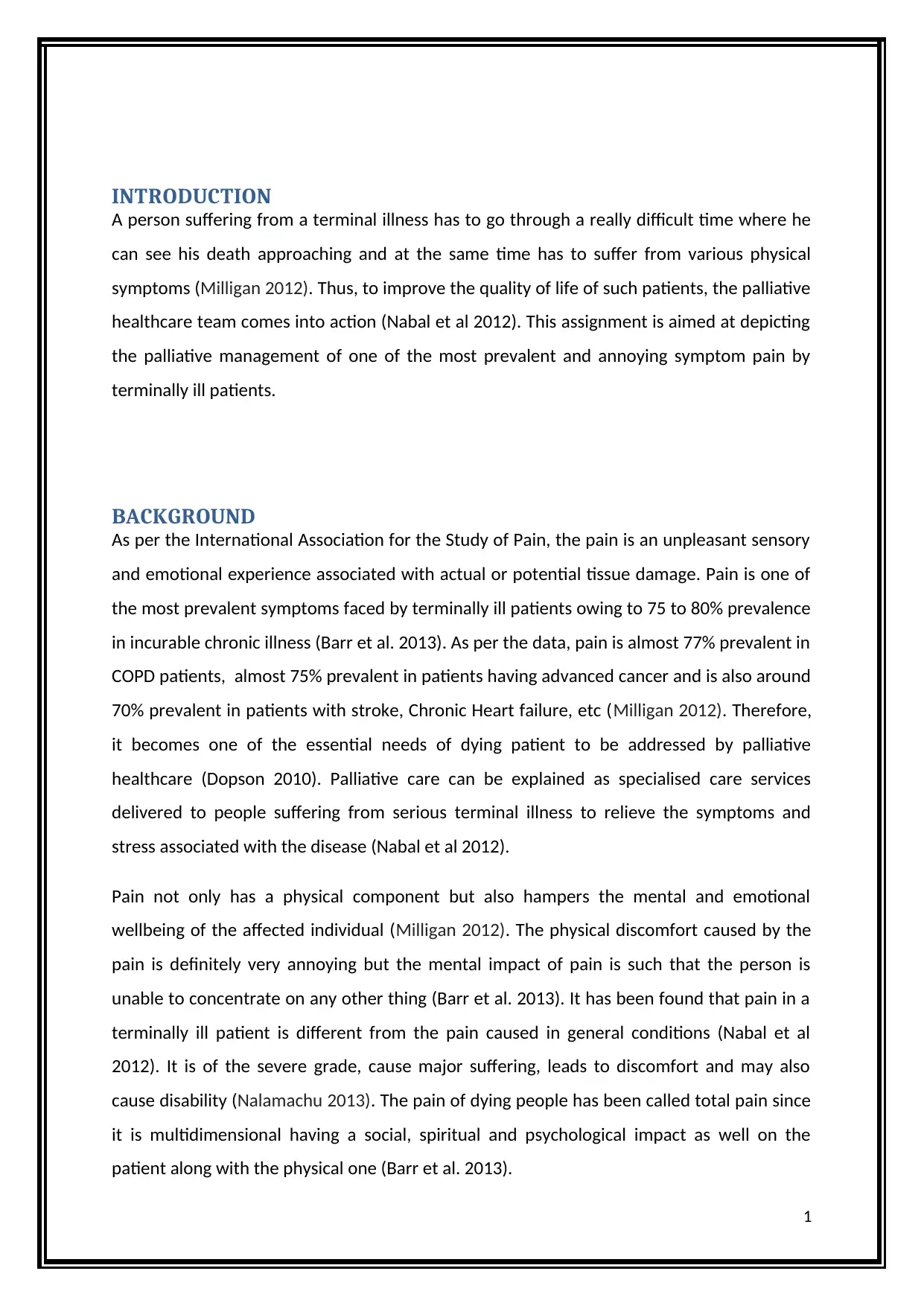
INTRODUCTION
A person suffering from a terminal illness has to go through a really difficult time where he
can see his death approaching and at the same time has to suffer from various physical
symptoms (Milligan 2012). Thus, to improve the quality of life of such patients, the palliative
healthcare team comes into action (Nabal et al 2012). This assignment is aimed at depicting
the palliative management of one of the most prevalent and annoying symptom pain by
terminally ill patients.
BACKGROUND
As per the International Association for the Study of Pain, the pain is an unpleasant sensory
and emotional experience associated with actual or potential tissue damage. Pain is one of
the most prevalent symptoms faced by terminally ill patients owing to 75 to 80% prevalence
in incurable chronic illness (Barr et al. 2013). As per the data, pain is almost 77% prevalent in
COPD patients, almost 75% prevalent in patients having advanced cancer and is also around
70% prevalent in patients with stroke, Chronic Heart failure, etc (Milligan 2012). Therefore,
it becomes one of the essential needs of dying patient to be addressed by palliative
healthcare (Dopson 2010). Palliative care can be explained as specialised care services
delivered to people suffering from serious terminal illness to relieve the symptoms and
stress associated with the disease (Nabal et al 2012).
Pain not only has a physical component but also hampers the mental and emotional
wellbeing of the affected individual (Milligan 2012). The physical discomfort caused by the
pain is definitely very annoying but the mental impact of pain is such that the person is
unable to concentrate on any other thing (Barr et al. 2013). It has been found that pain in a
terminally ill patient is different from the pain caused in general conditions (Nabal et al
2012). It is of the severe grade, cause major suffering, leads to discomfort and may also
cause disability (Nalamachu 2013). The pain of dying people has been called total pain since
it is multidimensional having a social, spiritual and psychological impact as well on the
patient along with the physical one (Barr et al. 2013).
1
A person suffering from a terminal illness has to go through a really difficult time where he
can see his death approaching and at the same time has to suffer from various physical
symptoms (Milligan 2012). Thus, to improve the quality of life of such patients, the palliative
healthcare team comes into action (Nabal et al 2012). This assignment is aimed at depicting
the palliative management of one of the most prevalent and annoying symptom pain by
terminally ill patients.
BACKGROUND
As per the International Association for the Study of Pain, the pain is an unpleasant sensory
and emotional experience associated with actual or potential tissue damage. Pain is one of
the most prevalent symptoms faced by terminally ill patients owing to 75 to 80% prevalence
in incurable chronic illness (Barr et al. 2013). As per the data, pain is almost 77% prevalent in
COPD patients, almost 75% prevalent in patients having advanced cancer and is also around
70% prevalent in patients with stroke, Chronic Heart failure, etc (Milligan 2012). Therefore,
it becomes one of the essential needs of dying patient to be addressed by palliative
healthcare (Dopson 2010). Palliative care can be explained as specialised care services
delivered to people suffering from serious terminal illness to relieve the symptoms and
stress associated with the disease (Nabal et al 2012).
Pain not only has a physical component but also hampers the mental and emotional
wellbeing of the affected individual (Milligan 2012). The physical discomfort caused by the
pain is definitely very annoying but the mental impact of pain is such that the person is
unable to concentrate on any other thing (Barr et al. 2013). It has been found that pain in a
terminally ill patient is different from the pain caused in general conditions (Nabal et al
2012). It is of the severe grade, cause major suffering, leads to discomfort and may also
cause disability (Nalamachu 2013). The pain of dying people has been called total pain since
it is multidimensional having a social, spiritual and psychological impact as well on the
patient along with the physical one (Barr et al. 2013).
1
Secure Best Marks with AI Grader
Need help grading? Try our AI Grader for instant feedback on your assignments.
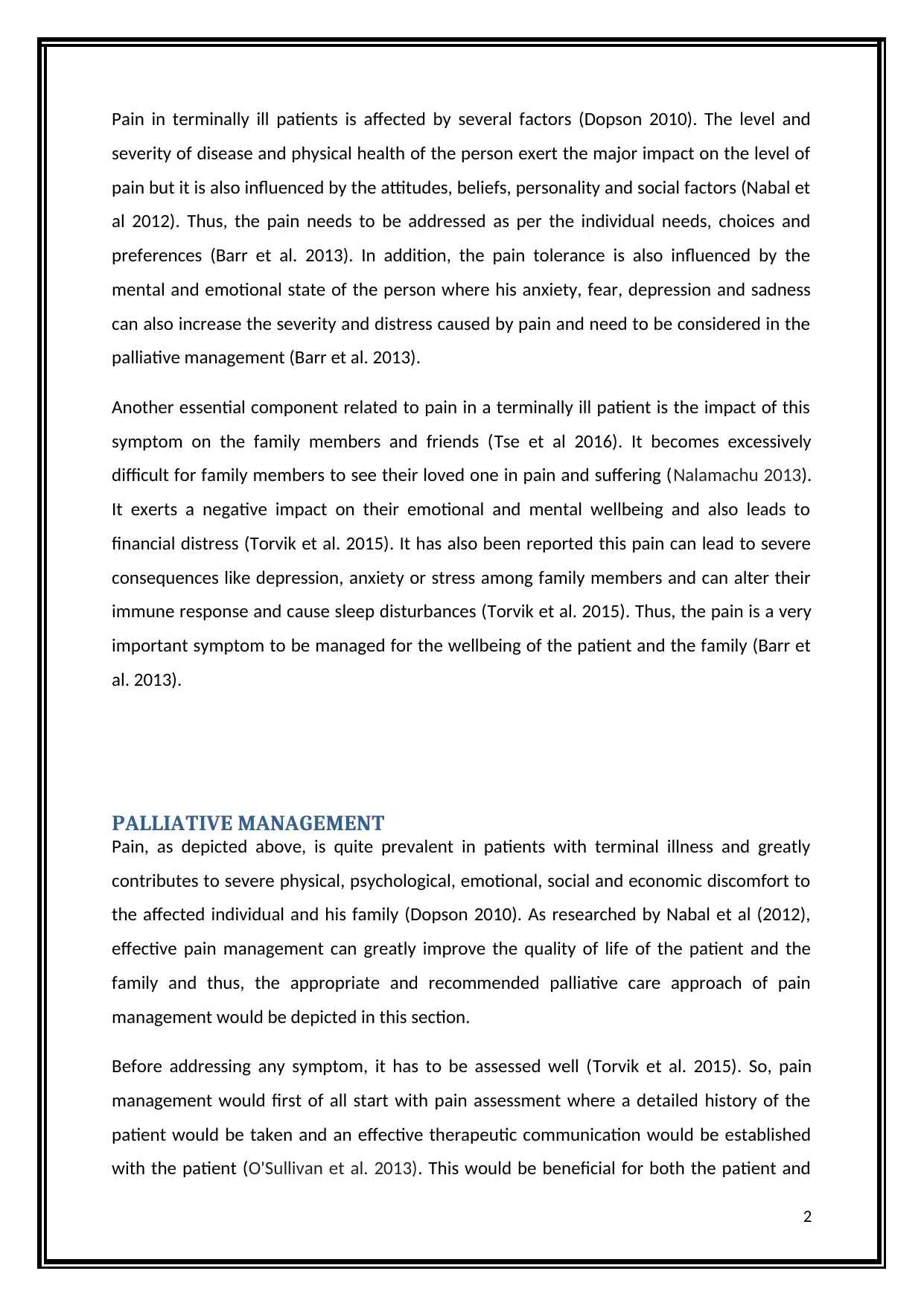
Pain in terminally ill patients is affected by several factors (Dopson 2010). The level and
severity of disease and physical health of the person exert the major impact on the level of
pain but it is also influenced by the attitudes, beliefs, personality and social factors (Nabal et
al 2012). Thus, the pain needs to be addressed as per the individual needs, choices and
preferences (Barr et al. 2013). In addition, the pain tolerance is also influenced by the
mental and emotional state of the person where his anxiety, fear, depression and sadness
can also increase the severity and distress caused by pain and need to be considered in the
palliative management (Barr et al. 2013).
Another essential component related to pain in a terminally ill patient is the impact of this
symptom on the family members and friends (Tse et al 2016). It becomes excessively
difficult for family members to see their loved one in pain and suffering (Nalamachu 2013).
It exerts a negative impact on their emotional and mental wellbeing and also leads to
financial distress (Torvik et al. 2015). It has also been reported this pain can lead to severe
consequences like depression, anxiety or stress among family members and can alter their
immune response and cause sleep disturbances (Torvik et al. 2015). Thus, the pain is a very
important symptom to be managed for the wellbeing of the patient and the family (Barr et
al. 2013).
PALLIATIVE MANAGEMENT
Pain, as depicted above, is quite prevalent in patients with terminal illness and greatly
contributes to severe physical, psychological, emotional, social and economic discomfort to
the affected individual and his family (Dopson 2010). As researched by Nabal et al (2012),
effective pain management can greatly improve the quality of life of the patient and the
family and thus, the appropriate and recommended palliative care approach of pain
management would be depicted in this section.
Before addressing any symptom, it has to be assessed well (Torvik et al. 2015). So, pain
management would first of all start with pain assessment where a detailed history of the
patient would be taken and an effective therapeutic communication would be established
with the patient (O'Sullivan et al. 2013). This would be beneficial for both the patient and
2
severity of disease and physical health of the person exert the major impact on the level of
pain but it is also influenced by the attitudes, beliefs, personality and social factors (Nabal et
al 2012). Thus, the pain needs to be addressed as per the individual needs, choices and
preferences (Barr et al. 2013). In addition, the pain tolerance is also influenced by the
mental and emotional state of the person where his anxiety, fear, depression and sadness
can also increase the severity and distress caused by pain and need to be considered in the
palliative management (Barr et al. 2013).
Another essential component related to pain in a terminally ill patient is the impact of this
symptom on the family members and friends (Tse et al 2016). It becomes excessively
difficult for family members to see their loved one in pain and suffering (Nalamachu 2013).
It exerts a negative impact on their emotional and mental wellbeing and also leads to
financial distress (Torvik et al. 2015). It has also been reported this pain can lead to severe
consequences like depression, anxiety or stress among family members and can alter their
immune response and cause sleep disturbances (Torvik et al. 2015). Thus, the pain is a very
important symptom to be managed for the wellbeing of the patient and the family (Barr et
al. 2013).
PALLIATIVE MANAGEMENT
Pain, as depicted above, is quite prevalent in patients with terminal illness and greatly
contributes to severe physical, psychological, emotional, social and economic discomfort to
the affected individual and his family (Dopson 2010). As researched by Nabal et al (2012),
effective pain management can greatly improve the quality of life of the patient and the
family and thus, the appropriate and recommended palliative care approach of pain
management would be depicted in this section.
Before addressing any symptom, it has to be assessed well (Torvik et al. 2015). So, pain
management would first of all start with pain assessment where a detailed history of the
patient would be taken and an effective therapeutic communication would be established
with the patient (O'Sullivan et al. 2013). This would be beneficial for both the patient and
2
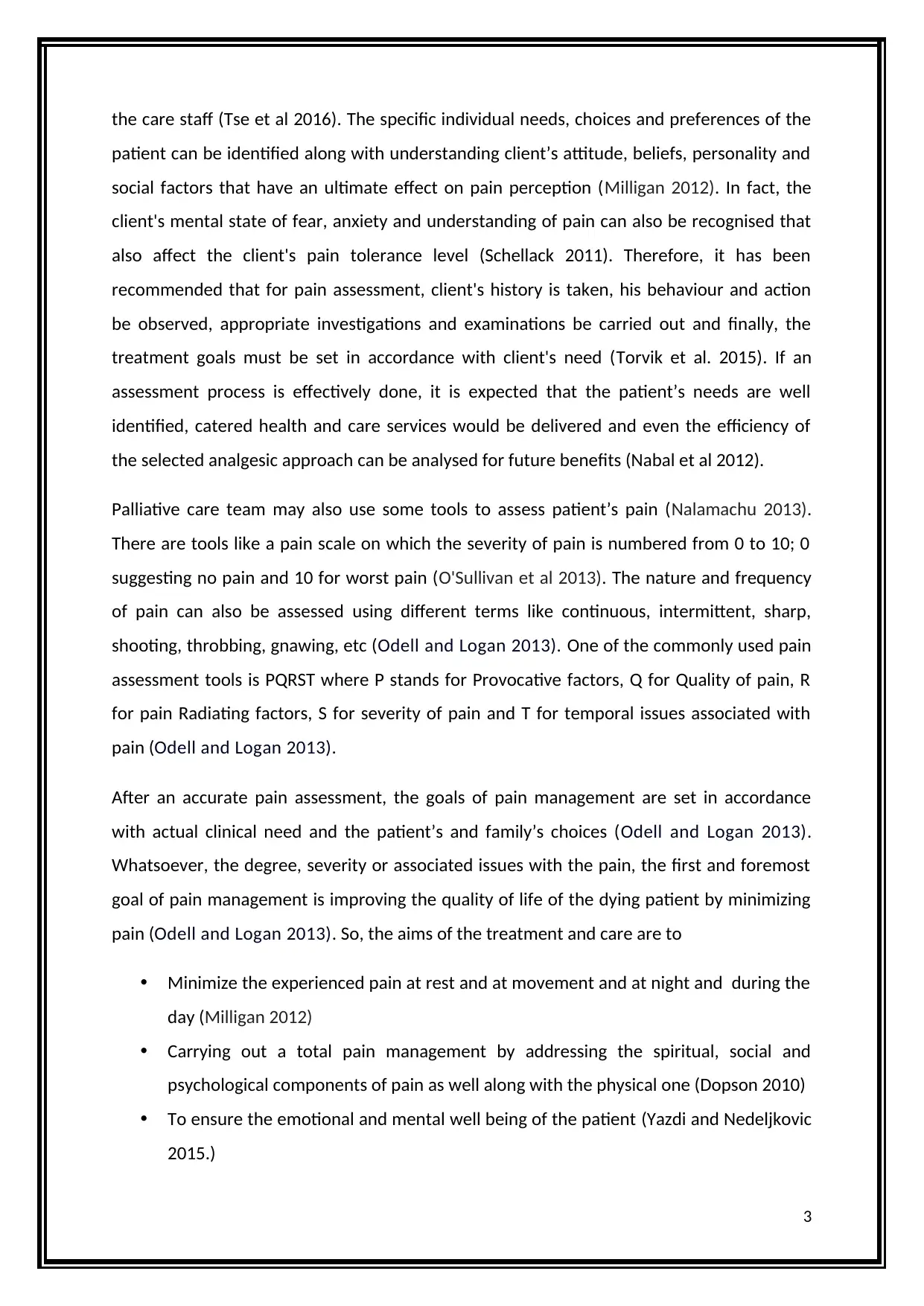
the care staff (Tse et al 2016). The specific individual needs, choices and preferences of the
patient can be identified along with understanding client’s attitude, beliefs, personality and
social factors that have an ultimate effect on pain perception (Milligan 2012). In fact, the
client's mental state of fear, anxiety and understanding of pain can also be recognised that
also affect the client's pain tolerance level (Schellack 2011). Therefore, it has been
recommended that for pain assessment, client's history is taken, his behaviour and action
be observed, appropriate investigations and examinations be carried out and finally, the
treatment goals must be set in accordance with client's need (Torvik et al. 2015). If an
assessment process is effectively done, it is expected that the patient’s needs are well
identified, catered health and care services would be delivered and even the efficiency of
the selected analgesic approach can be analysed for future benefits (Nabal et al 2012).
Palliative care team may also use some tools to assess patient’s pain (Nalamachu 2013).
There are tools like a pain scale on which the severity of pain is numbered from 0 to 10; 0
suggesting no pain and 10 for worst pain (O'Sullivan et al 2013). The nature and frequency
of pain can also be assessed using different terms like continuous, intermittent, sharp,
shooting, throbbing, gnawing, etc (Odell and Logan 2013). One of the commonly used pain
assessment tools is PQRST where P stands for Provocative factors, Q for Quality of pain, R
for pain Radiating factors, S for severity of pain and T for temporal issues associated with
pain (Odell and Logan 2013).
After an accurate pain assessment, the goals of pain management are set in accordance
with actual clinical need and the patient’s and family’s choices (Odell and Logan 2013).
Whatsoever, the degree, severity or associated issues with the pain, the first and foremost
goal of pain management is improving the quality of life of the dying patient by minimizing
pain (Odell and Logan 2013). So, the aims of the treatment and care are to
Minimize the experienced pain at rest and at movement and at night and during the
day (Milligan 2012)
Carrying out a total pain management by addressing the spiritual, social and
psychological components of pain as well along with the physical one (Dopson 2010)
To ensure the emotional and mental well being of the patient (Yazdi and Nedeljkovic
2015.)
3
patient can be identified along with understanding client’s attitude, beliefs, personality and
social factors that have an ultimate effect on pain perception (Milligan 2012). In fact, the
client's mental state of fear, anxiety and understanding of pain can also be recognised that
also affect the client's pain tolerance level (Schellack 2011). Therefore, it has been
recommended that for pain assessment, client's history is taken, his behaviour and action
be observed, appropriate investigations and examinations be carried out and finally, the
treatment goals must be set in accordance with client's need (Torvik et al. 2015). If an
assessment process is effectively done, it is expected that the patient’s needs are well
identified, catered health and care services would be delivered and even the efficiency of
the selected analgesic approach can be analysed for future benefits (Nabal et al 2012).
Palliative care team may also use some tools to assess patient’s pain (Nalamachu 2013).
There are tools like a pain scale on which the severity of pain is numbered from 0 to 10; 0
suggesting no pain and 10 for worst pain (O'Sullivan et al 2013). The nature and frequency
of pain can also be assessed using different terms like continuous, intermittent, sharp,
shooting, throbbing, gnawing, etc (Odell and Logan 2013). One of the commonly used pain
assessment tools is PQRST where P stands for Provocative factors, Q for Quality of pain, R
for pain Radiating factors, S for severity of pain and T for temporal issues associated with
pain (Odell and Logan 2013).
After an accurate pain assessment, the goals of pain management are set in accordance
with actual clinical need and the patient’s and family’s choices (Odell and Logan 2013).
Whatsoever, the degree, severity or associated issues with the pain, the first and foremost
goal of pain management is improving the quality of life of the dying patient by minimizing
pain (Odell and Logan 2013). So, the aims of the treatment and care are to
Minimize the experienced pain at rest and at movement and at night and during the
day (Milligan 2012)
Carrying out a total pain management by addressing the spiritual, social and
psychological components of pain as well along with the physical one (Dopson 2010)
To ensure the emotional and mental well being of the patient (Yazdi and Nedeljkovic
2015.)
3
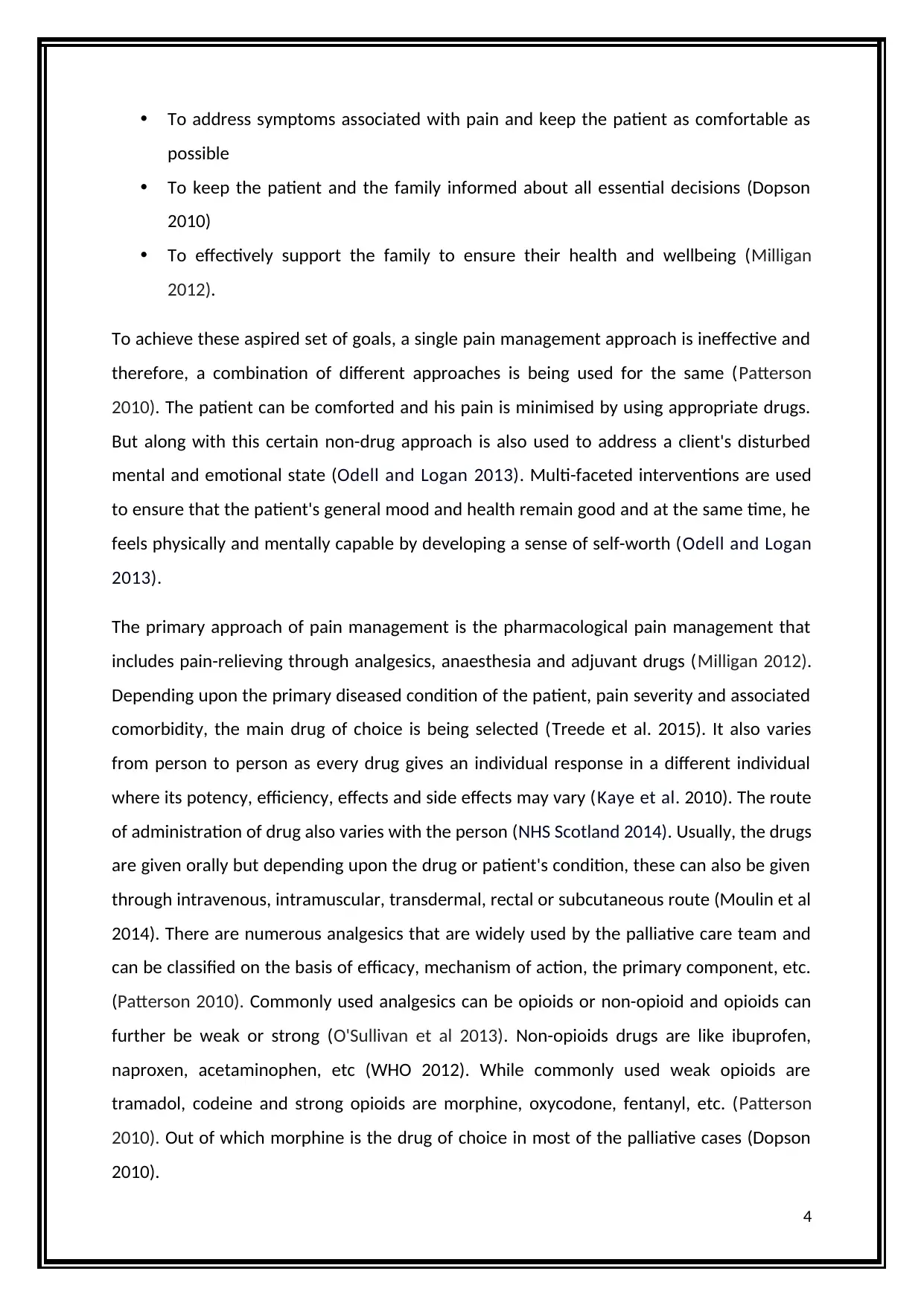
To address symptoms associated with pain and keep the patient as comfortable as
possible
To keep the patient and the family informed about all essential decisions (Dopson
2010)
To effectively support the family to ensure their health and wellbeing (Milligan
2012).
To achieve these aspired set of goals, a single pain management approach is ineffective and
therefore, a combination of different approaches is being used for the same (Patterson
2010). The patient can be comforted and his pain is minimised by using appropriate drugs.
But along with this certain non-drug approach is also used to address a client's disturbed
mental and emotional state (Odell and Logan 2013). Multi-faceted interventions are used
to ensure that the patient's general mood and health remain good and at the same time, he
feels physically and mentally capable by developing a sense of self-worth (Odell and Logan
2013).
The primary approach of pain management is the pharmacological pain management that
includes pain-relieving through analgesics, anaesthesia and adjuvant drugs (Milligan 2012).
Depending upon the primary diseased condition of the patient, pain severity and associated
comorbidity, the main drug of choice is being selected (Treede et al. 2015). It also varies
from person to person as every drug gives an individual response in a different individual
where its potency, efficiency, effects and side effects may vary (Kaye et al. 2010). The route
of administration of drug also varies with the person (NHS Scotland 2014). Usually, the drugs
are given orally but depending upon the drug or patient's condition, these can also be given
through intravenous, intramuscular, transdermal, rectal or subcutaneous route (Moulin et al
2014). There are numerous analgesics that are widely used by the palliative care team and
can be classified on the basis of efficacy, mechanism of action, the primary component, etc.
(Patterson 2010). Commonly used analgesics can be opioids or non-opioid and opioids can
further be weak or strong (O'Sullivan et al 2013). Non-opioids drugs are like ibuprofen,
naproxen, acetaminophen, etc (WHO 2012). While commonly used weak opioids are
tramadol, codeine and strong opioids are morphine, oxycodone, fentanyl, etc. (Patterson
2010). Out of which morphine is the drug of choice in most of the palliative cases (Dopson
2010).
4
possible
To keep the patient and the family informed about all essential decisions (Dopson
2010)
To effectively support the family to ensure their health and wellbeing (Milligan
2012).
To achieve these aspired set of goals, a single pain management approach is ineffective and
therefore, a combination of different approaches is being used for the same (Patterson
2010). The patient can be comforted and his pain is minimised by using appropriate drugs.
But along with this certain non-drug approach is also used to address a client's disturbed
mental and emotional state (Odell and Logan 2013). Multi-faceted interventions are used
to ensure that the patient's general mood and health remain good and at the same time, he
feels physically and mentally capable by developing a sense of self-worth (Odell and Logan
2013).
The primary approach of pain management is the pharmacological pain management that
includes pain-relieving through analgesics, anaesthesia and adjuvant drugs (Milligan 2012).
Depending upon the primary diseased condition of the patient, pain severity and associated
comorbidity, the main drug of choice is being selected (Treede et al. 2015). It also varies
from person to person as every drug gives an individual response in a different individual
where its potency, efficiency, effects and side effects may vary (Kaye et al. 2010). The route
of administration of drug also varies with the person (NHS Scotland 2014). Usually, the drugs
are given orally but depending upon the drug or patient's condition, these can also be given
through intravenous, intramuscular, transdermal, rectal or subcutaneous route (Moulin et al
2014). There are numerous analgesics that are widely used by the palliative care team and
can be classified on the basis of efficacy, mechanism of action, the primary component, etc.
(Patterson 2010). Commonly used analgesics can be opioids or non-opioid and opioids can
further be weak or strong (O'Sullivan et al 2013). Non-opioids drugs are like ibuprofen,
naproxen, acetaminophen, etc (WHO 2012). While commonly used weak opioids are
tramadol, codeine and strong opioids are morphine, oxycodone, fentanyl, etc. (Patterson
2010). Out of which morphine is the drug of choice in most of the palliative cases (Dopson
2010).
4
Secure Best Marks with AI Grader
Need help grading? Try our AI Grader for instant feedback on your assignments.
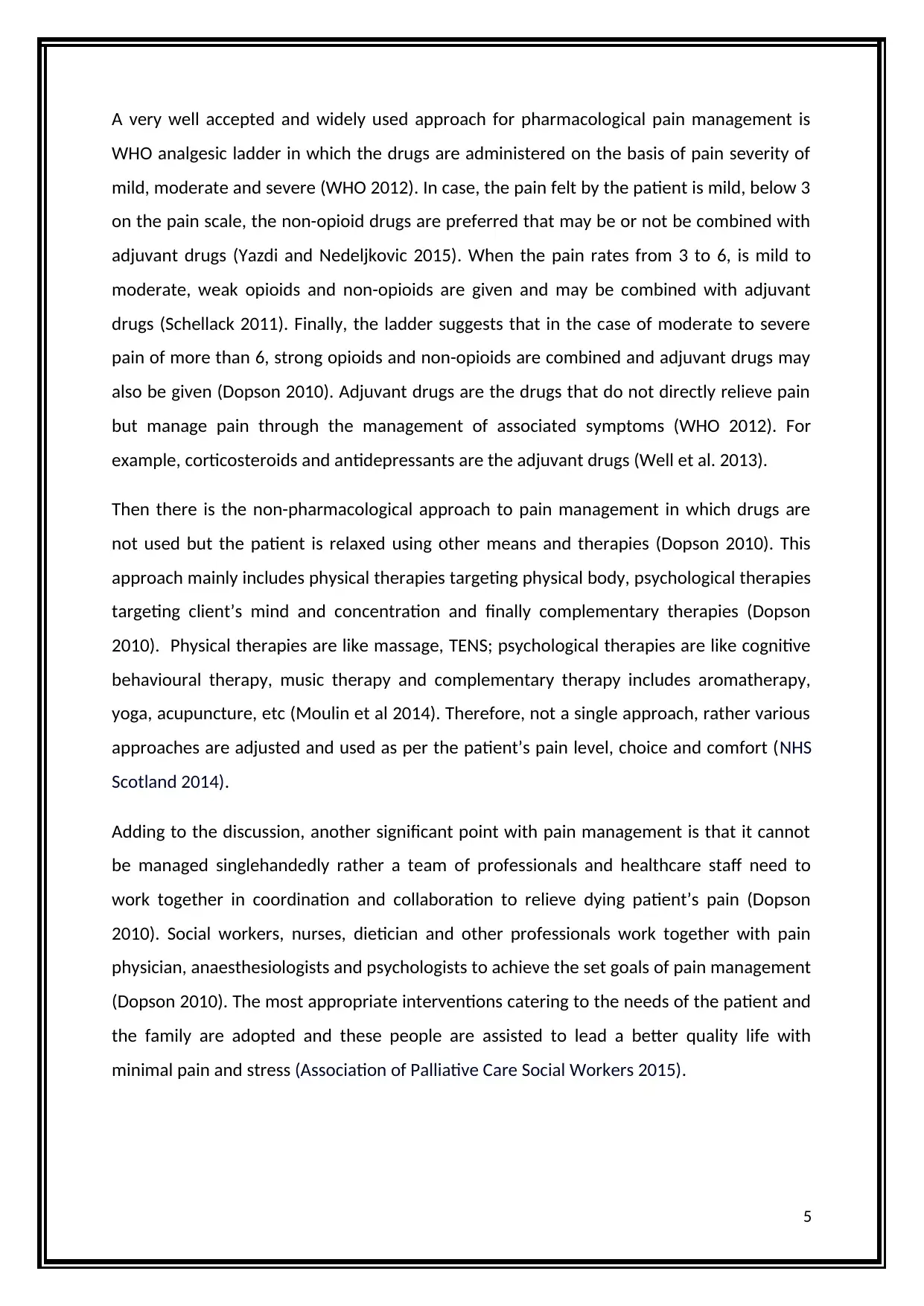
A very well accepted and widely used approach for pharmacological pain management is
WHO analgesic ladder in which the drugs are administered on the basis of pain severity of
mild, moderate and severe (WHO 2012). In case, the pain felt by the patient is mild, below 3
on the pain scale, the non-opioid drugs are preferred that may be or not be combined with
adjuvant drugs (Yazdi and Nedeljkovic 2015). When the pain rates from 3 to 6, is mild to
moderate, weak opioids and non-opioids are given and may be combined with adjuvant
drugs (Schellack 2011). Finally, the ladder suggests that in the case of moderate to severe
pain of more than 6, strong opioids and non-opioids are combined and adjuvant drugs may
also be given (Dopson 2010). Adjuvant drugs are the drugs that do not directly relieve pain
but manage pain through the management of associated symptoms (WHO 2012). For
example, corticosteroids and antidepressants are the adjuvant drugs (Well et al. 2013).
Then there is the non-pharmacological approach to pain management in which drugs are
not used but the patient is relaxed using other means and therapies (Dopson 2010). This
approach mainly includes physical therapies targeting physical body, psychological therapies
targeting client’s mind and concentration and finally complementary therapies (Dopson
2010). Physical therapies are like massage, TENS; psychological therapies are like cognitive
behavioural therapy, music therapy and complementary therapy includes aromatherapy,
yoga, acupuncture, etc (Moulin et al 2014). Therefore, not a single approach, rather various
approaches are adjusted and used as per the patient’s pain level, choice and comfort (NHS
Scotland 2014).
Adding to the discussion, another significant point with pain management is that it cannot
be managed singlehandedly rather a team of professionals and healthcare staff need to
work together in coordination and collaboration to relieve dying patient’s pain (Dopson
2010). Social workers, nurses, dietician and other professionals work together with pain
physician, anaesthesiologists and psychologists to achieve the set goals of pain management
(Dopson 2010). The most appropriate interventions catering to the needs of the patient and
the family are adopted and these people are assisted to lead a better quality life with
minimal pain and stress (Association of Palliative Care Social Workers 2015).
5
WHO analgesic ladder in which the drugs are administered on the basis of pain severity of
mild, moderate and severe (WHO 2012). In case, the pain felt by the patient is mild, below 3
on the pain scale, the non-opioid drugs are preferred that may be or not be combined with
adjuvant drugs (Yazdi and Nedeljkovic 2015). When the pain rates from 3 to 6, is mild to
moderate, weak opioids and non-opioids are given and may be combined with adjuvant
drugs (Schellack 2011). Finally, the ladder suggests that in the case of moderate to severe
pain of more than 6, strong opioids and non-opioids are combined and adjuvant drugs may
also be given (Dopson 2010). Adjuvant drugs are the drugs that do not directly relieve pain
but manage pain through the management of associated symptoms (WHO 2012). For
example, corticosteroids and antidepressants are the adjuvant drugs (Well et al. 2013).
Then there is the non-pharmacological approach to pain management in which drugs are
not used but the patient is relaxed using other means and therapies (Dopson 2010). This
approach mainly includes physical therapies targeting physical body, psychological therapies
targeting client’s mind and concentration and finally complementary therapies (Dopson
2010). Physical therapies are like massage, TENS; psychological therapies are like cognitive
behavioural therapy, music therapy and complementary therapy includes aromatherapy,
yoga, acupuncture, etc (Moulin et al 2014). Therefore, not a single approach, rather various
approaches are adjusted and used as per the patient’s pain level, choice and comfort (NHS
Scotland 2014).
Adding to the discussion, another significant point with pain management is that it cannot
be managed singlehandedly rather a team of professionals and healthcare staff need to
work together in coordination and collaboration to relieve dying patient’s pain (Dopson
2010). Social workers, nurses, dietician and other professionals work together with pain
physician, anaesthesiologists and psychologists to achieve the set goals of pain management
(Dopson 2010). The most appropriate interventions catering to the needs of the patient and
the family are adopted and these people are assisted to lead a better quality life with
minimal pain and stress (Association of Palliative Care Social Workers 2015).
5
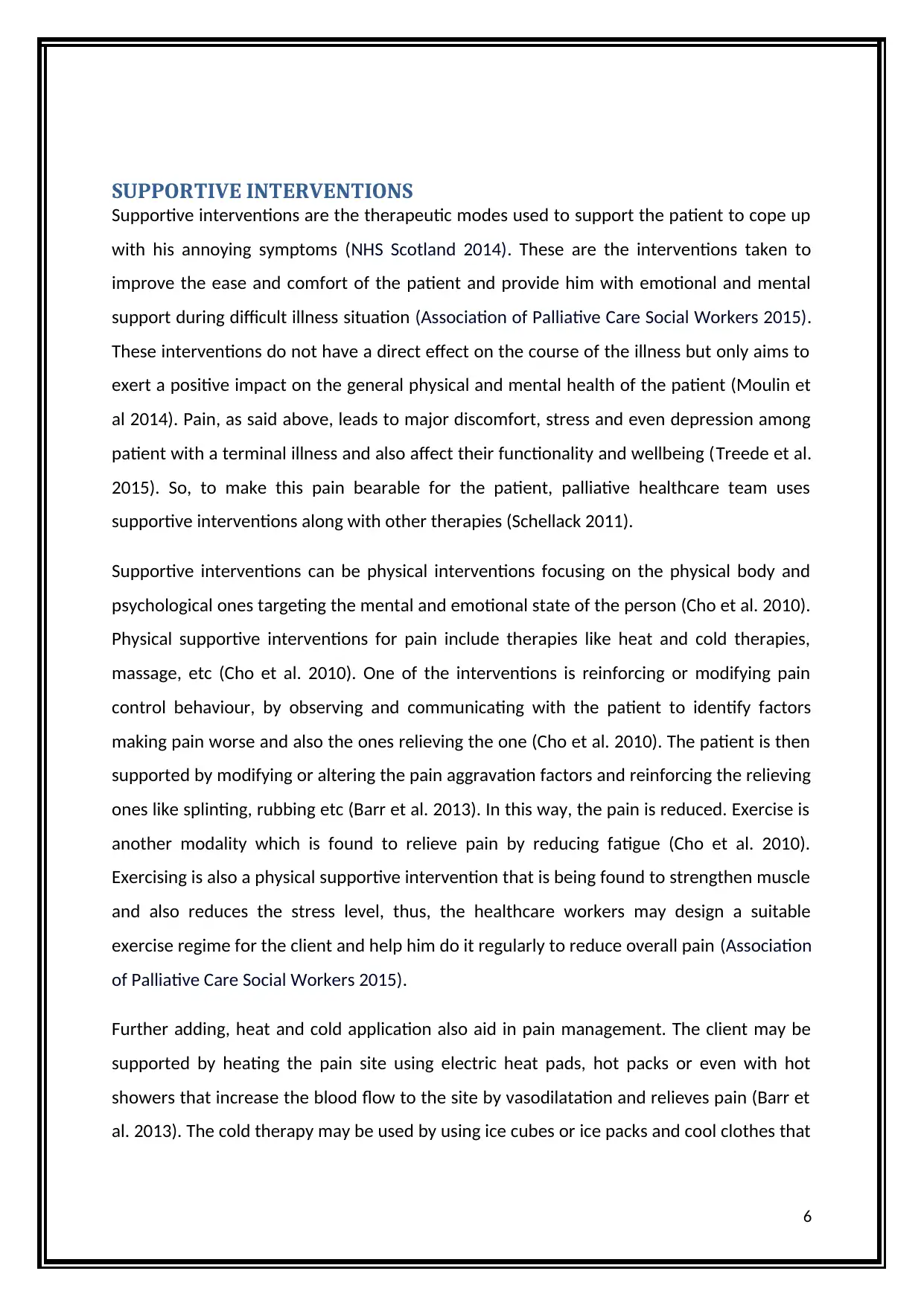
SUPPORTIVE INTERVENTIONS
Supportive interventions are the therapeutic modes used to support the patient to cope up
with his annoying symptoms (NHS Scotland 2014). These are the interventions taken to
improve the ease and comfort of the patient and provide him with emotional and mental
support during difficult illness situation (Association of Palliative Care Social Workers 2015).
These interventions do not have a direct effect on the course of the illness but only aims to
exert a positive impact on the general physical and mental health of the patient (Moulin et
al 2014). Pain, as said above, leads to major discomfort, stress and even depression among
patient with a terminal illness and also affect their functionality and wellbeing (Treede et al.
2015). So, to make this pain bearable for the patient, palliative healthcare team uses
supportive interventions along with other therapies (Schellack 2011).
Supportive interventions can be physical interventions focusing on the physical body and
psychological ones targeting the mental and emotional state of the person (Cho et al. 2010).
Physical supportive interventions for pain include therapies like heat and cold therapies,
massage, etc (Cho et al. 2010). One of the interventions is reinforcing or modifying pain
control behaviour, by observing and communicating with the patient to identify factors
making pain worse and also the ones relieving the one (Cho et al. 2010). The patient is then
supported by modifying or altering the pain aggravation factors and reinforcing the relieving
ones like splinting, rubbing etc (Barr et al. 2013). In this way, the pain is reduced. Exercise is
another modality which is found to relieve pain by reducing fatigue (Cho et al. 2010).
Exercising is also a physical supportive intervention that is being found to strengthen muscle
and also reduces the stress level, thus, the healthcare workers may design a suitable
exercise regime for the client and help him do it regularly to reduce overall pain (Association
of Palliative Care Social Workers 2015).
Further adding, heat and cold application also aid in pain management. The client may be
supported by heating the pain site using electric heat pads, hot packs or even with hot
showers that increase the blood flow to the site by vasodilatation and relieves pain (Barr et
al. 2013). The cold therapy may be used by using ice cubes or ice packs and cool clothes that
6
Supportive interventions are the therapeutic modes used to support the patient to cope up
with his annoying symptoms (NHS Scotland 2014). These are the interventions taken to
improve the ease and comfort of the patient and provide him with emotional and mental
support during difficult illness situation (Association of Palliative Care Social Workers 2015).
These interventions do not have a direct effect on the course of the illness but only aims to
exert a positive impact on the general physical and mental health of the patient (Moulin et
al 2014). Pain, as said above, leads to major discomfort, stress and even depression among
patient with a terminal illness and also affect their functionality and wellbeing (Treede et al.
2015). So, to make this pain bearable for the patient, palliative healthcare team uses
supportive interventions along with other therapies (Schellack 2011).
Supportive interventions can be physical interventions focusing on the physical body and
psychological ones targeting the mental and emotional state of the person (Cho et al. 2010).
Physical supportive interventions for pain include therapies like heat and cold therapies,
massage, etc (Cho et al. 2010). One of the interventions is reinforcing or modifying pain
control behaviour, by observing and communicating with the patient to identify factors
making pain worse and also the ones relieving the one (Cho et al. 2010). The patient is then
supported by modifying or altering the pain aggravation factors and reinforcing the relieving
ones like splinting, rubbing etc (Barr et al. 2013). In this way, the pain is reduced. Exercise is
another modality which is found to relieve pain by reducing fatigue (Cho et al. 2010).
Exercising is also a physical supportive intervention that is being found to strengthen muscle
and also reduces the stress level, thus, the healthcare workers may design a suitable
exercise regime for the client and help him do it regularly to reduce overall pain (Association
of Palliative Care Social Workers 2015).
Further adding, heat and cold application also aid in pain management. The client may be
supported by heating the pain site using electric heat pads, hot packs or even with hot
showers that increase the blood flow to the site by vasodilatation and relieves pain (Barr et
al. 2013). The cold therapy may be used by using ice cubes or ice packs and cool clothes that
6
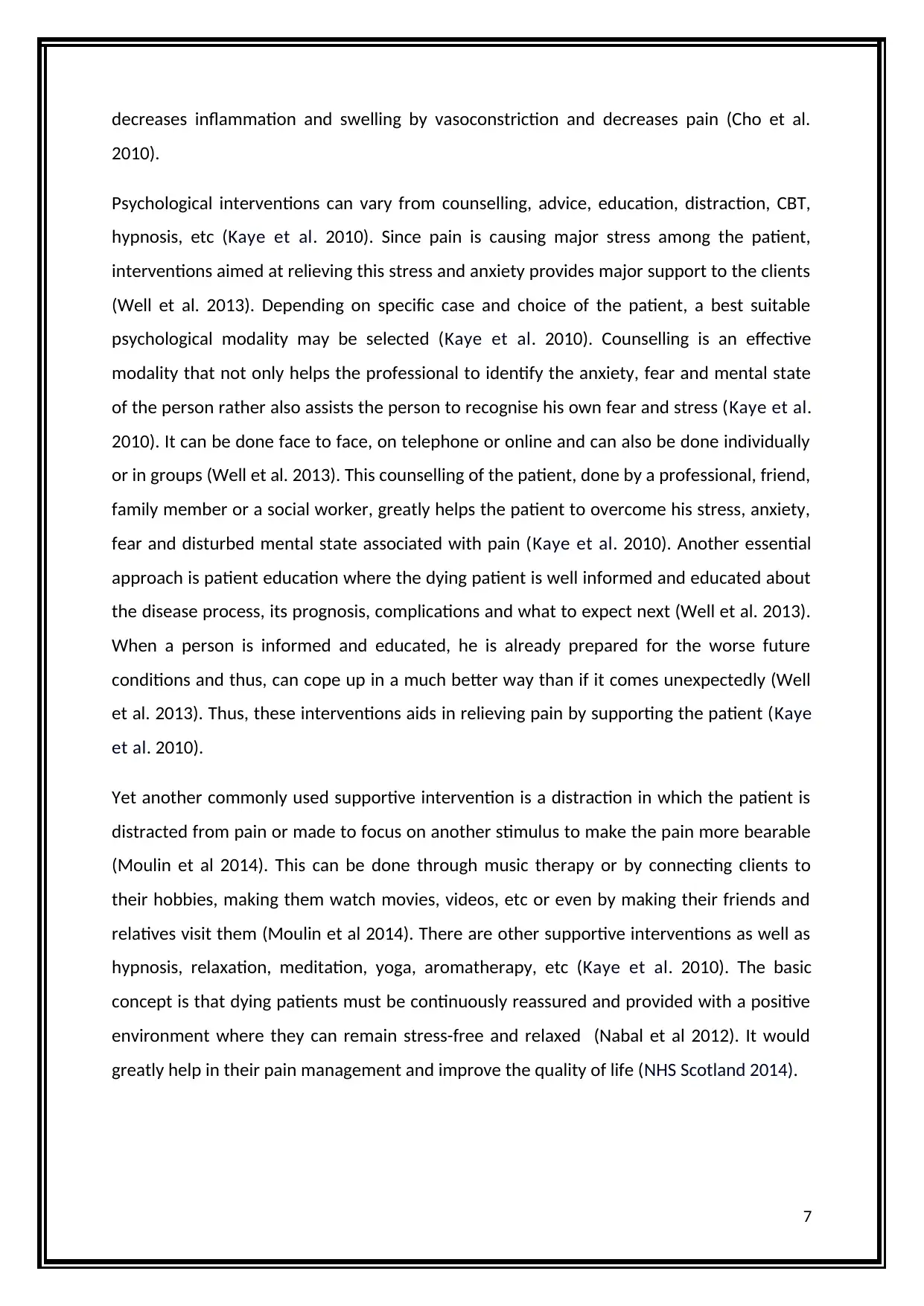
decreases inflammation and swelling by vasoconstriction and decreases pain (Cho et al.
2010).
Psychological interventions can vary from counselling, advice, education, distraction, CBT,
hypnosis, etc (Kaye et al. 2010). Since pain is causing major stress among the patient,
interventions aimed at relieving this stress and anxiety provides major support to the clients
(Well et al. 2013). Depending on specific case and choice of the patient, a best suitable
psychological modality may be selected (Kaye et al. 2010). Counselling is an effective
modality that not only helps the professional to identify the anxiety, fear and mental state
of the person rather also assists the person to recognise his own fear and stress (Kaye et al.
2010). It can be done face to face, on telephone or online and can also be done individually
or in groups (Well et al. 2013). This counselling of the patient, done by a professional, friend,
family member or a social worker, greatly helps the patient to overcome his stress, anxiety,
fear and disturbed mental state associated with pain (Kaye et al. 2010). Another essential
approach is patient education where the dying patient is well informed and educated about
the disease process, its prognosis, complications and what to expect next (Well et al. 2013).
When a person is informed and educated, he is already prepared for the worse future
conditions and thus, can cope up in a much better way than if it comes unexpectedly (Well
et al. 2013). Thus, these interventions aids in relieving pain by supporting the patient (Kaye
et al. 2010).
Yet another commonly used supportive intervention is a distraction in which the patient is
distracted from pain or made to focus on another stimulus to make the pain more bearable
(Moulin et al 2014). This can be done through music therapy or by connecting clients to
their hobbies, making them watch movies, videos, etc or even by making their friends and
relatives visit them (Moulin et al 2014). There are other supportive interventions as well as
hypnosis, relaxation, meditation, yoga, aromatherapy, etc (Kaye et al. 2010). The basic
concept is that dying patients must be continuously reassured and provided with a positive
environment where they can remain stress-free and relaxed (Nabal et al 2012). It would
greatly help in their pain management and improve the quality of life (NHS Scotland 2014).
7
2010).
Psychological interventions can vary from counselling, advice, education, distraction, CBT,
hypnosis, etc (Kaye et al. 2010). Since pain is causing major stress among the patient,
interventions aimed at relieving this stress and anxiety provides major support to the clients
(Well et al. 2013). Depending on specific case and choice of the patient, a best suitable
psychological modality may be selected (Kaye et al. 2010). Counselling is an effective
modality that not only helps the professional to identify the anxiety, fear and mental state
of the person rather also assists the person to recognise his own fear and stress (Kaye et al.
2010). It can be done face to face, on telephone or online and can also be done individually
or in groups (Well et al. 2013). This counselling of the patient, done by a professional, friend,
family member or a social worker, greatly helps the patient to overcome his stress, anxiety,
fear and disturbed mental state associated with pain (Kaye et al. 2010). Another essential
approach is patient education where the dying patient is well informed and educated about
the disease process, its prognosis, complications and what to expect next (Well et al. 2013).
When a person is informed and educated, he is already prepared for the worse future
conditions and thus, can cope up in a much better way than if it comes unexpectedly (Well
et al. 2013). Thus, these interventions aids in relieving pain by supporting the patient (Kaye
et al. 2010).
Yet another commonly used supportive intervention is a distraction in which the patient is
distracted from pain or made to focus on another stimulus to make the pain more bearable
(Moulin et al 2014). This can be done through music therapy or by connecting clients to
their hobbies, making them watch movies, videos, etc or even by making their friends and
relatives visit them (Moulin et al 2014). There are other supportive interventions as well as
hypnosis, relaxation, meditation, yoga, aromatherapy, etc (Kaye et al. 2010). The basic
concept is that dying patients must be continuously reassured and provided with a positive
environment where they can remain stress-free and relaxed (Nabal et al 2012). It would
greatly help in their pain management and improve the quality of life (NHS Scotland 2014).
7
Paraphrase This Document
Need a fresh take? Get an instant paraphrase of this document with our AI Paraphraser

CONCLUSION
From this assignment, it can be concluded that pain is a prevalent and annoying symptom in
people with terminal illness and leads to major physical and mental discomfort (Torvik et al.
2015). It also affects the lives of the family and relatives, so, the palliative healthcare team
has come up with various pain management approaches including drug therapy, non-drug
therapy and supportive interventions that not only decreases the physical impact of pain
but also reduces its mental and emotional impact (Treede et al. 2015).
8
From this assignment, it can be concluded that pain is a prevalent and annoying symptom in
people with terminal illness and leads to major physical and mental discomfort (Torvik et al.
2015). It also affects the lives of the family and relatives, so, the palliative healthcare team
has come up with various pain management approaches including drug therapy, non-drug
therapy and supportive interventions that not only decreases the physical impact of pain
but also reduces its mental and emotional impact (Treede et al. 2015).
8
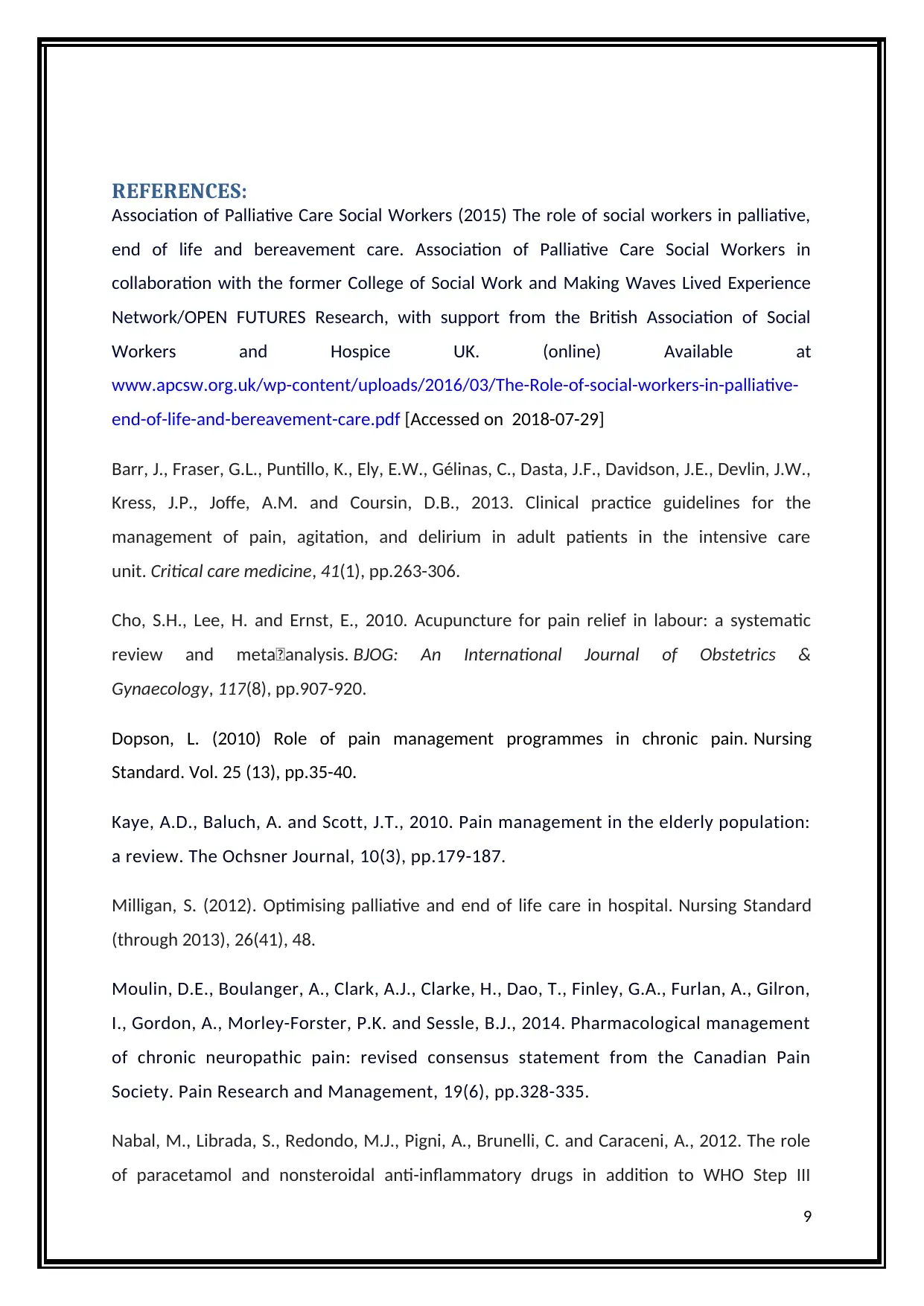
REFERENCES:
Association of Palliative Care Social Workers (2015) The role of social workers in palliative,
end of life and bereavement care. Association of Palliative Care Social Workers in
collaboration with the former College of Social Work and Making Waves Lived Experience
Network/OPEN FUTURES Research, with support from the British Association of Social
Workers and Hospice UK. (online) Available at
www.apcsw.org.uk/wp-content/uploads/2016/03/The-Role-of-social-workers-in-palliative-
end-of-life-and-bereavement-care.pdf [Accessed on 2018-07-29]
Barr, J., Fraser, G.L., Puntillo, K., Ely, E.W., Gélinas, C., Dasta, J.F., Davidson, J.E., Devlin, J.W.,
Kress, J.P., Joffe, A.M. and Coursin, D.B., 2013. Clinical practice guidelines for the
management of pain, agitation, and delirium in adult patients in the intensive care
unit. Critical care medicine, 41(1), pp.263-306.
Cho, S.H., Lee, H. and Ernst, E., 2010. Acupuncture for pain relief in labour: a systematic
review and meta‐analysis. BJOG: An International Journal of Obstetrics &
Gynaecology, 117(8), pp.907-920.
Dopson, L. (2010) Role of pain management programmes in chronic pain. Nursing
Standard. Vol. 25 (13), pp.35-40.
Kaye, A.D., Baluch, A. and Scott, J.T., 2010. Pain management in the elderly population:
a review. The Ochsner Journal, 10(3), pp.179-187.
Milligan, S. (2012). Optimising palliative and end of life care in hospital. Nursing Standard
(through 2013), 26(41), 48.
Moulin, D.E., Boulanger, A., Clark, A.J., Clarke, H., Dao, T., Finley, G.A., Furlan, A., Gilron,
I., Gordon, A., Morley-Forster, P.K. and Sessle, B.J., 2014. Pharmacological management
of chronic neuropathic pain: revised consensus statement from the Canadian Pain
Society. Pain Research and Management, 19(6), pp.328-335.
Nabal, M., Librada, S., Redondo, M.J., Pigni, A., Brunelli, C. and Caraceni, A., 2012. The role
of paracetamol and nonsteroidal anti-inflammatory drugs in addition to WHO Step III
9
Association of Palliative Care Social Workers (2015) The role of social workers in palliative,
end of life and bereavement care. Association of Palliative Care Social Workers in
collaboration with the former College of Social Work and Making Waves Lived Experience
Network/OPEN FUTURES Research, with support from the British Association of Social
Workers and Hospice UK. (online) Available at
www.apcsw.org.uk/wp-content/uploads/2016/03/The-Role-of-social-workers-in-palliative-
end-of-life-and-bereavement-care.pdf [Accessed on 2018-07-29]
Barr, J., Fraser, G.L., Puntillo, K., Ely, E.W., Gélinas, C., Dasta, J.F., Davidson, J.E., Devlin, J.W.,
Kress, J.P., Joffe, A.M. and Coursin, D.B., 2013. Clinical practice guidelines for the
management of pain, agitation, and delirium in adult patients in the intensive care
unit. Critical care medicine, 41(1), pp.263-306.
Cho, S.H., Lee, H. and Ernst, E., 2010. Acupuncture for pain relief in labour: a systematic
review and meta‐analysis. BJOG: An International Journal of Obstetrics &
Gynaecology, 117(8), pp.907-920.
Dopson, L. (2010) Role of pain management programmes in chronic pain. Nursing
Standard. Vol. 25 (13), pp.35-40.
Kaye, A.D., Baluch, A. and Scott, J.T., 2010. Pain management in the elderly population:
a review. The Ochsner Journal, 10(3), pp.179-187.
Milligan, S. (2012). Optimising palliative and end of life care in hospital. Nursing Standard
(through 2013), 26(41), 48.
Moulin, D.E., Boulanger, A., Clark, A.J., Clarke, H., Dao, T., Finley, G.A., Furlan, A., Gilron,
I., Gordon, A., Morley-Forster, P.K. and Sessle, B.J., 2014. Pharmacological management
of chronic neuropathic pain: revised consensus statement from the Canadian Pain
Society. Pain Research and Management, 19(6), pp.328-335.
Nabal, M., Librada, S., Redondo, M.J., Pigni, A., Brunelli, C. and Caraceni, A., 2012. The role
of paracetamol and nonsteroidal anti-inflammatory drugs in addition to WHO Step III
9
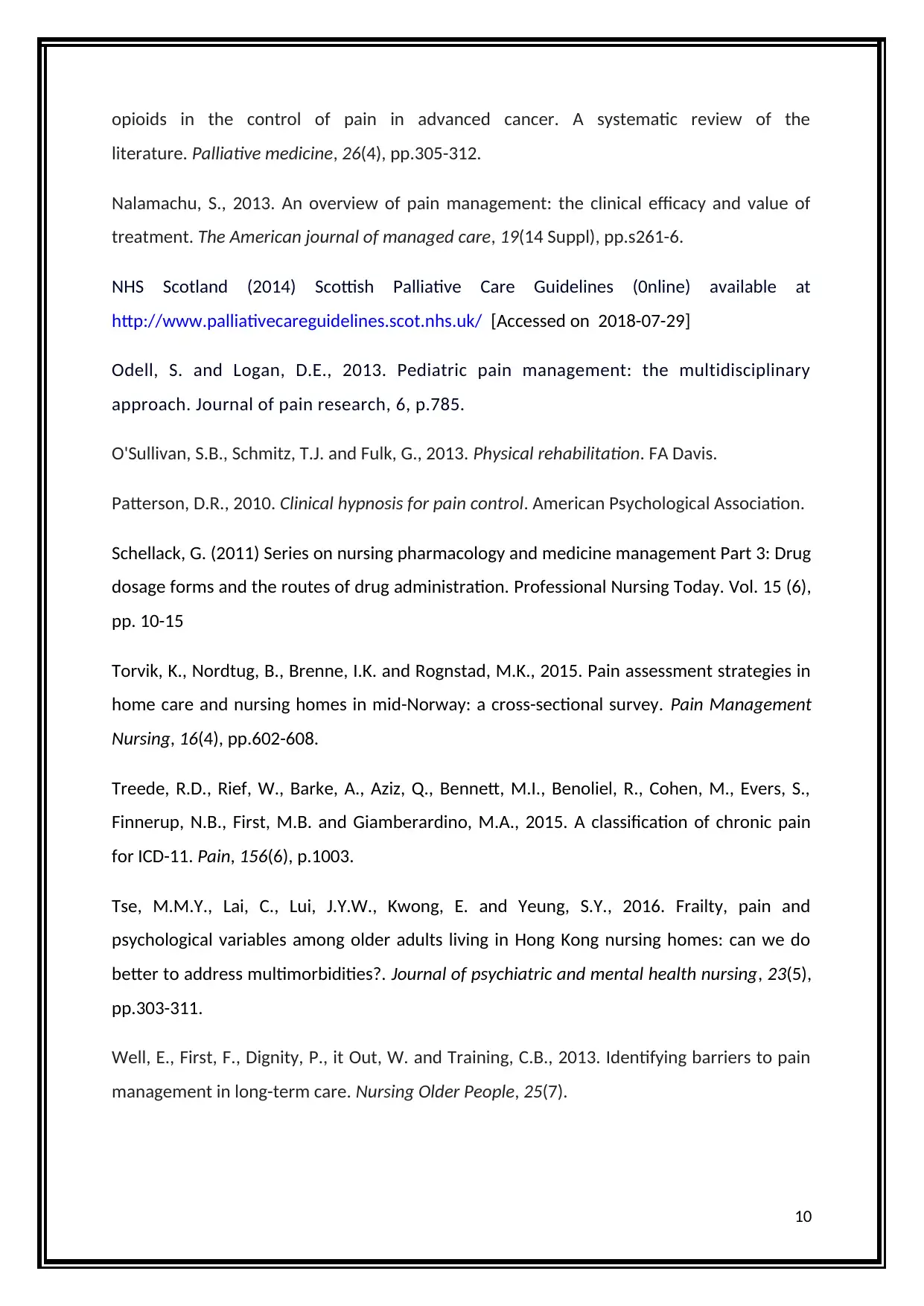
opioids in the control of pain in advanced cancer. A systematic review of the
literature. Palliative medicine, 26(4), pp.305-312.
Nalamachu, S., 2013. An overview of pain management: the clinical efficacy and value of
treatment. The American journal of managed care, 19(14 Suppl), pp.s261-6.
NHS Scotland (2014) Scottish Palliative Care Guidelines (0nline) available at
http://www.palliativecareguidelines.scot.nhs.uk/ [Accessed on 2018-07-29]
Odell, S. and Logan, D.E., 2013. Pediatric pain management: the multidisciplinary
approach. Journal of pain research, 6, p.785.
O'Sullivan, S.B., Schmitz, T.J. and Fulk, G., 2013. Physical rehabilitation. FA Davis.
Patterson, D.R., 2010. Clinical hypnosis for pain control. American Psychological Association.
Schellack, G. (2011) Series on nursing pharmacology and medicine management Part 3: Drug
dosage forms and the routes of drug administration. Professional Nursing Today. Vol. 15 (6),
pp. 10-15
Torvik, K., Nordtug, B., Brenne, I.K. and Rognstad, M.K., 2015. Pain assessment strategies in
home care and nursing homes in mid-Norway: a cross-sectional survey. Pain Management
Nursing, 16(4), pp.602-608.
Treede, R.D., Rief, W., Barke, A., Aziz, Q., Bennett, M.I., Benoliel, R., Cohen, M., Evers, S.,
Finnerup, N.B., First, M.B. and Giamberardino, M.A., 2015. A classification of chronic pain
for ICD-11. Pain, 156(6), p.1003.
Tse, M.M.Y., Lai, C., Lui, J.Y.W., Kwong, E. and Yeung, S.Y., 2016. Frailty, pain and
psychological variables among older adults living in Hong Kong nursing homes: can we do
better to address multimorbidities?. Journal of psychiatric and mental health nursing, 23(5),
pp.303-311.
Well, E., First, F., Dignity, P., it Out, W. and Training, C.B., 2013. Identifying barriers to pain
management in long-term care. Nursing Older People, 25(7).
10
literature. Palliative medicine, 26(4), pp.305-312.
Nalamachu, S., 2013. An overview of pain management: the clinical efficacy and value of
treatment. The American journal of managed care, 19(14 Suppl), pp.s261-6.
NHS Scotland (2014) Scottish Palliative Care Guidelines (0nline) available at
http://www.palliativecareguidelines.scot.nhs.uk/ [Accessed on 2018-07-29]
Odell, S. and Logan, D.E., 2013. Pediatric pain management: the multidisciplinary
approach. Journal of pain research, 6, p.785.
O'Sullivan, S.B., Schmitz, T.J. and Fulk, G., 2013. Physical rehabilitation. FA Davis.
Patterson, D.R., 2010. Clinical hypnosis for pain control. American Psychological Association.
Schellack, G. (2011) Series on nursing pharmacology and medicine management Part 3: Drug
dosage forms and the routes of drug administration. Professional Nursing Today. Vol. 15 (6),
pp. 10-15
Torvik, K., Nordtug, B., Brenne, I.K. and Rognstad, M.K., 2015. Pain assessment strategies in
home care and nursing homes in mid-Norway: a cross-sectional survey. Pain Management
Nursing, 16(4), pp.602-608.
Treede, R.D., Rief, W., Barke, A., Aziz, Q., Bennett, M.I., Benoliel, R., Cohen, M., Evers, S.,
Finnerup, N.B., First, M.B. and Giamberardino, M.A., 2015. A classification of chronic pain
for ICD-11. Pain, 156(6), p.1003.
Tse, M.M.Y., Lai, C., Lui, J.Y.W., Kwong, E. and Yeung, S.Y., 2016. Frailty, pain and
psychological variables among older adults living in Hong Kong nursing homes: can we do
better to address multimorbidities?. Journal of psychiatric and mental health nursing, 23(5),
pp.303-311.
Well, E., First, F., Dignity, P., it Out, W. and Training, C.B., 2013. Identifying barriers to pain
management in long-term care. Nursing Older People, 25(7).
10
Secure Best Marks with AI Grader
Need help grading? Try our AI Grader for instant feedback on your assignments.
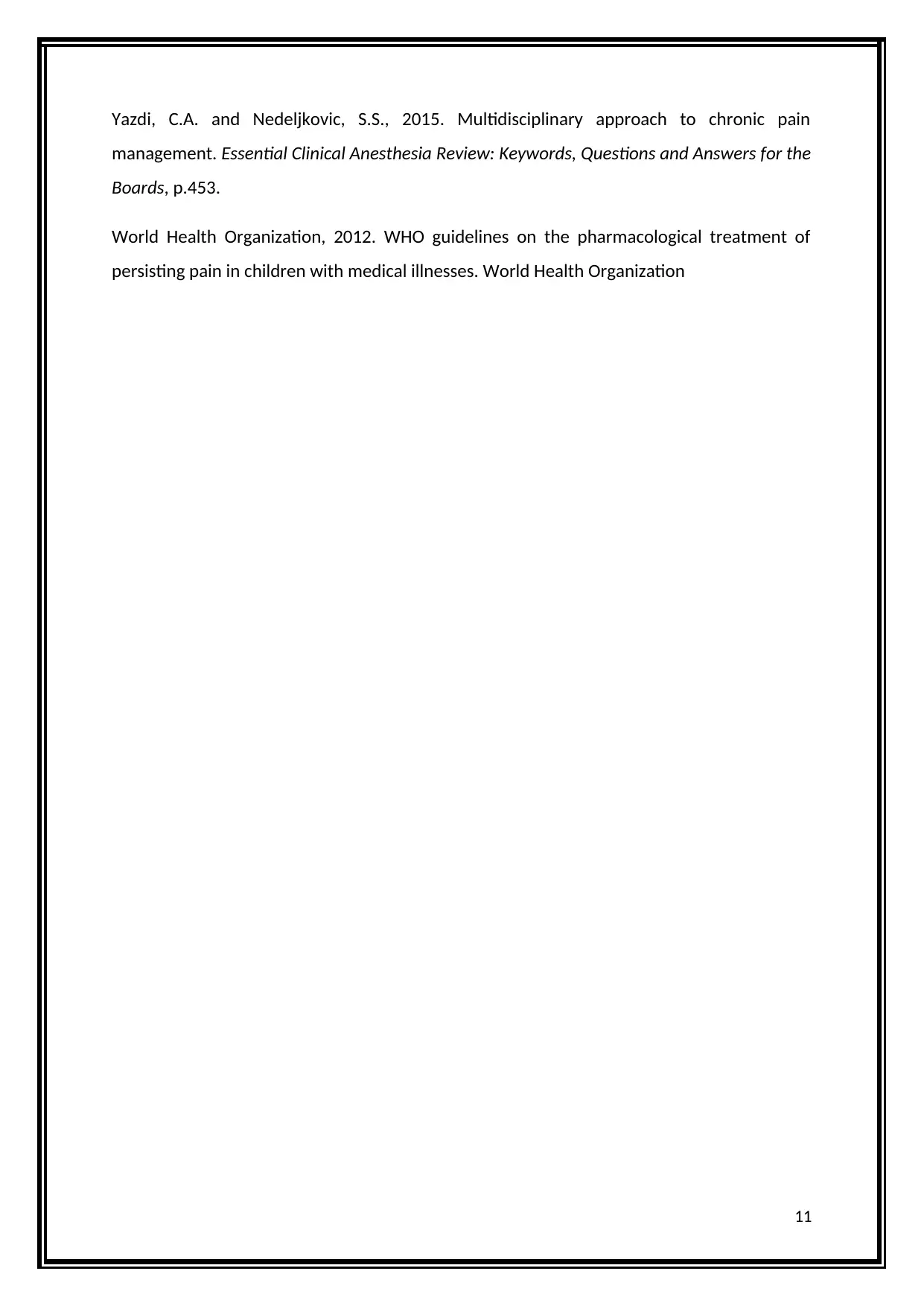
Yazdi, C.A. and Nedeljkovic, S.S., 2015. Multidisciplinary approach to chronic pain
management. Essential Clinical Anesthesia Review: Keywords, Questions and Answers for the
Boards, p.453.
World Health Organization, 2012. WHO guidelines on the pharmacological treatment of
persisting pain in children with medical illnesses. World Health Organization
11
management. Essential Clinical Anesthesia Review: Keywords, Questions and Answers for the
Boards, p.453.
World Health Organization, 2012. WHO guidelines on the pharmacological treatment of
persisting pain in children with medical illnesses. World Health Organization
11
1 out of 11
Related Documents
Your All-in-One AI-Powered Toolkit for Academic Success.
+13062052269
info@desklib.com
Available 24*7 on WhatsApp / Email
![[object Object]](/_next/static/media/star-bottom.7253800d.svg)
Unlock your academic potential
© 2024 | Zucol Services PVT LTD | All rights reserved.





